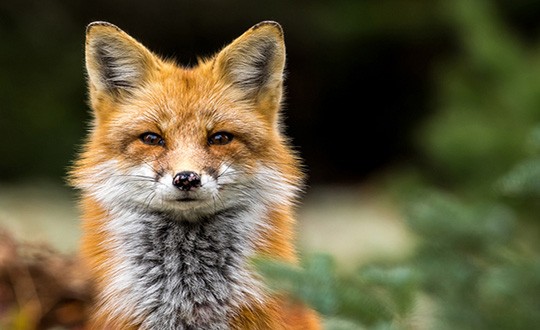Seven Habits of the Successful Pet Photographer
Whether they're cute or ferocious, you want to immortalize your family pet on film. Don't worry if your Beagle, Siamese, or Iguana is camera shy, these little devils can't escape NYI photographers! We are here to help you with our Seven Habits of the Successful Pet Photographer. To learn the basic functions of your camera so you can capture the best shots of your furry friends, check out our fundamentals of digital photography course. So fluff up your Persian and let's get started!
1. Get inside your pet's brain.
For a portrait, you want your four-legged buddy to feel at ease so why not try to contain him or her in their favorite hang out-be it the rocking chair on the front porch, the stoop, on top of the fridge, or on top of your desk. Many cats like to rest on top of reading material, not for the intellectual stimulation, but to prevent their masters from reading so that they can get all the attention.
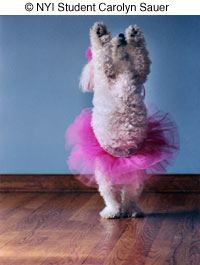
You should always respect your pet's personality when taking a photo just as you would for a human subject. Here's an ethical question for you. Should pet owners resist the urge of draping them in Versace? Does this really humiliate the animal? Well, we should probably leave that for your local pet psychic to answer. Chances are, though, if you dress your Saint Bernard up in red raincoat and booties, you're not going to get a natural expression. We leave this to your discretion. The NYI staff has fallen in love with this photo taken by NYI Student Carolyn Sauer of this poodle in his pink tutu. We suspect that this puppy was begging for treats and oblivious to her ballerina get-up. By the way, take a look at this puppy's feet – in first position of ballet!
2. Thou Shalt Tell A Story.
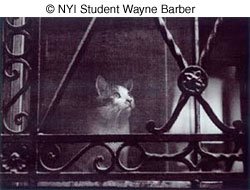
See this cat behind the screen looking out? We can imagine the story behind this photo. It is a look that cat owners will recognize – that hypnotic stare that a cat gets when it intently studies a feathered object that it would like to nibble on. Next time you see a photo of a pet, see if it tells a story. It doesn't have to be a long story. It can be a short story as in this poodle in the pink tutu. Let's say you're trying to take a photo of your golden retriever and in walks your toddler with an ice cream cone and your golden retriever then knocks the cone out of his hands. The end result will be a photo that speaks for itself!
It's a good idea to have your camera at a central location in your home so you can grab it the second you see an animal story.
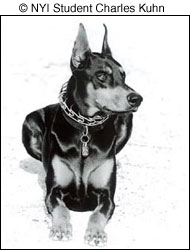
3. Be prepared for sudden movement.
Pets can be unpredictable and move without warning. Consider your photo session a jungle safari of sorts and prepare for the cheetah's sudden escape. Sometimes pets can be restless and jump at the sound of a shutter click, so you should adjust your camera accordingly. Set your shutter speed at about 1/125th so your tabby doesn't come across as one big orange fuzz ball. With film use a high speed such as ISO 400 or 800 film if you are going to be photographing indoors with minimal available light.
Pets can be just as vain as their masters. You can make a shiny coat of fur look even better by using a soft light or catching your pet taking a late afternoon sunbath.
4. Control the clutter on the set.
Though you will not have to deal with the model's ill-coordinated clothing, you still don't want to photograph your Dalmatian against a drab shower curtain.
Remember, follow your pet's thought process – eat, sleep, play – in other words – simplify! Once you decide on the location of your photo session, if it is indoors remember to get rid of clutter – stray magic markers, dirty socks, human limbs, TV Guides – things that distract and do not add to the story behind the photo. Outdoors, watch out for lawn furniture, stray toys and other debris that can complicate your background.
This brings us to our fifth Habit.
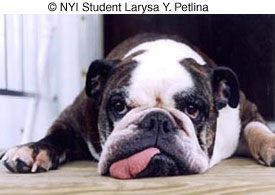
5. Consider your camera angle.
It's a good idea to place the camera at about the same level of the animal. This will fill your frame with your furry subject. If you're outdoors and your subject is digging for treasures or eating your neighbor's tulips, get down in the dirt so you can be at the same level. Seeing the subject's point of view, can give you an extra creative spark which will lead to better photographs.
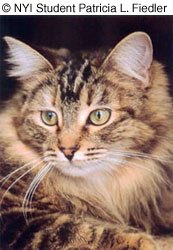
If you are aiming for a glamorous close-up shot as in NYI Student Patricia Fielder's photo of her cat, you will want to use a close-up lens and be very quiet so you don't interrupt kitty's trance. Oh, what beautiful fur this cat has! A pet photograph doesn't always do justice to the subject's fur.
6. Don't forget the treats and the props!
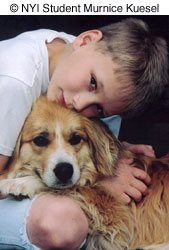
Treats are tools of the trade in pet photography. If you know your pet has a weakness for...say carrot cake, liverwurst, or peanut butter, do not be afraid to use these to help you take that unforgettable shot. This can work especially well when photographing people with pets. (Though, you may want to get your vet's approval for the peanut butter.) If you want to have a great portrait of your child and pet, try getting the child and the pet to look in the same direction. Make sure the child is comfortable with the pet and vice versa. The child can cuddle the animal if it is small enough or stroke it if the animal towers over the child. It probably isn't a good idea to have the child play rodeo and ride it around the living room. The trick is to show the relationship between the pet and the person in the picture.
In NYI's Lesson on Child Photography and Pet Photography, we offer this inside tip: If you want two animals to "cuddle," try rubbing some food behind the ear of one of them – then be prepared to shoot fast! If you are shooting a group of puppies or kittens, think about placing them in one place – a basket, sink, tub, or mailbox so you can contain in one area.
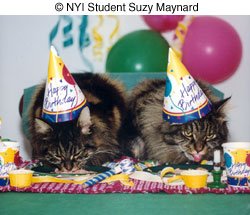
Make that tuna frosting, please! As you can see from this cute birthday party photo, props can really help your create a great photo. NYI Student Suzy Maynard of Pennsylvania took this photo. I think the cats were so preoccupied with the food, that they don't seem to be bothered a bit by the silly birthday hats and cat sized cups.
7. Study your pet during the day.

What sets him apart from other animals? What weird habits does he have? If you were to interview one hundred cat owners, they would surely come up with one hundred different activities their cats like to do besides snoozing. Some cats like to wrestle with stuffed animals, chase flies, and lick the spaghetti pot. If you want to take a funny photograph, the key is in the behavior. Aside from their life of luxury (sleeping, chasing ghosts and shadows, and eating), what do they do to entertain themselves? Do they adopt the same habits and patterns of behavior as their master's?
Even though seeing pets dressed up in clothes, leather jackets, tutus, is cute some of the best photographs can be taken when the pet is oblivious to the camera-when you catch the animal's expression or when the animal has almost a human expression. Another approach to pet photography is to take a photo of your pet when he isn't looking. I suppose some animal activists may think this encroaches on the animal's privacy, but even such high profile pets like Barney, President Bush's dog, or Socks, the former White House cat have learned to live with their in-house photographer!
Tips for photographing reptiles, birds and other caged friends:
If your pet spends most of his life behind bars, it certainly makes sense to let him out for the photo shoot! Your Iguana will look much better lounging around the backyard than napping in a cage.
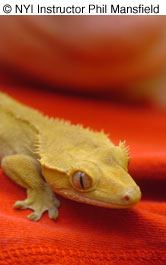
Snakes and other reptiles – If your significant other doesn't want to pose with this snake a la Natasha Kinski, there are plenty of other ways to photograph a snake. Be inventive! You can get a close up shot of the snake's face and eyes or put him on a table and photograph him from different angles. You can also experiment by placing your pet in an environment that is foreign to your pet. For example, you could place your pet frog on a satin pillow for a contrast in texture. Who knows? The frog might like it.
Birds – If you have trained Polly to rest on your finger then you shouldn't have a problem getting her to pose. Chances are your feathered creature is very colorful. Use this physical attribute to your best advantage. Make sure that your background does not clash with his colors. Make sure the background isn't too busy. Keep it simple; stick to solid crisp colors.
Fish – We did not want to leave out the goldfish groupies among you! If you want to take a good photo of your fish tank, follow these rules:
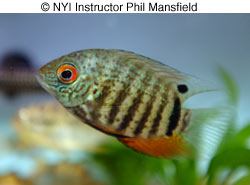
If you are not going to be using your flash, your best bet is to put your camera lens against the fish tank and wait for the fish to swim your way. The light from the aquarium will brighten your subject. If you are intent on using a flash, be sure to take the photo from an angle, a 60-degree angle is fine, so that you do not get a blinding hot spot.
Now that you know how to take great photos of your pampered pet, we wish you a good scratch-free photo session!
Learn how to capture the perfect pictures of your pets by taking photography classes with NYIP.



